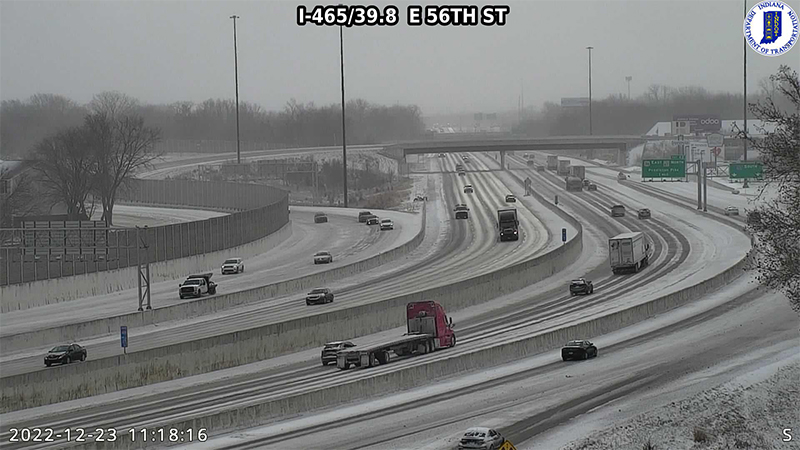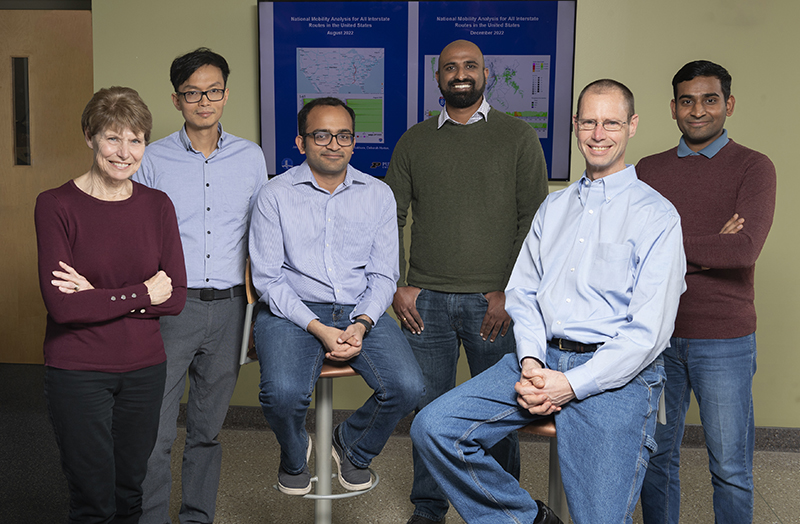
Purdue civil engineering is reaching beyond the view of highway cameras in Indiana and across the nation with research into using vehicle internet connections to determine high traffic congestion in real time and identify problem areas. (Photo provided by Indiana Department of Transportation)
WEST LAFAYETTE, Ind. – Purdue University researchers have developed techniques to harness big data from connected vehicles to monitor congestion caused by crashes, weather and construction. As part of their work, they analyzed over 503 billion records in December 2022 to monitor the national impact of a large winter storm.
The team is led by Darcy Bullock, the Lyles Family Professor of Civil Engineering in Purdue's Lyles School of Civil Engineering, and focuses on developing scalable techniques for measuring and graphically visualizing traffic congestion.
For many years, the U.S. Department of Transportation, universities and private sector companies have published annual congestion reports and rankings of states and cities. However, Bullock believes the new frontier is to develop techniques that use connected vehicle data to map out the time, location and severity of congestion in a uniform manner across all 50 states. This will provide a more robust systemwide characterization of interstate congestion to prioritize national infrastructure investments as well as monitor the resiliency of our network during large weather events such as winter storms or hurricanes.
 The Purdue Connected Vehicles Research Group: from left, Deborah Horton, managing director of the Joint Transportation Research Program; Howell Li, JTRP principal research analyst; Jairaj Desai, JTRP transportation research engineer; Jijo Mathew, JTRP transportation research engineer; Darcy Bullock, the Lyles Family Professor of Civil Engineering and JTRP director; and Rahul Sakhare, graduate research assistant. (Purdue University photo/John Underwood)
The Purdue Connected Vehicles Research Group: from left, Deborah Horton, managing director of the Joint Transportation Research Program; Howell Li, JTRP principal research analyst; Jairaj Desai, JTRP transportation research engineer; Jijo Mathew, JTRP transportation research engineer; Darcy Bullock, the Lyles Family Professor of Civil Engineering and JTRP director; and Rahul Sakhare, graduate research assistant. (Purdue University photo/John Underwood) "There are three key ingredients in this analysis: data, cloud platforms and graphic visualization methods. The combination enables decision makers to quickly understand how traffic is moving," said Howell Li, principal research analyst, who has worked with Wejo Data Services Inc. to analyze the data systematically in real time using Google's BigQuery. "On a typical Friday afternoon, Purdue ingests approximately 600,000 records per minute on just Indiana roads. At a national level, there are over 25 million connected vehicle records generated every minute."
Transportation research engineers Jairaj Desai and Jijo Mathew and PhD candidate Rahul Sakhare have developed analytical techniques for processing that data in real time to create graphical maps showing week-at-a-glance charts depicting the time, location and severity of traffic congestion. These same techniques could also be used to show how usage of electric vehicles and hybrid electric vehicles varied by states and interstate routes.
"Privacy is very important for all of our public and private sector partners," Bullock said. "Our connected vehicle data provider employs consented, deidentified and anonymized data that is consistent with both U.S. and EU general data protection regulations."
The Purdue team produced two major reports in 2022, one for August and the other for December. Although both reports used similar analysis techniques, the August report is a great tool to see the impact of construction work zones on mobility. The December report provides an example of the impact of a large winter storm moving across the U.S. and the subsequent state-by-state recovery. A video illustrating the national impact of that storm on I-80 can be seen at https://youtu.be/YrYz9CovAuA. State-by-state impact on all interstate routes can be found at https://doi.org/10.5703/1288284317591.
"From a national perspective, this is really valuable," Bullock said. "Data like this can show us our overall interstate network resiliency as well as provide insights to support operational decisions and long-term national infrastructure investments."






